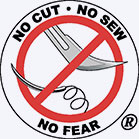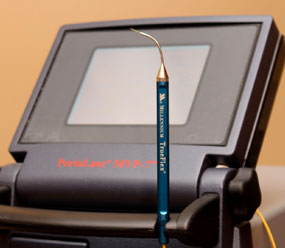CALL US 602-588-7777

For Patients with Gum Disease, we are pleased to announce that we now offer Laser Periodontal Therapy (LANAP*) for patients who have gum disease (periodontitis). LANAP is a revolutionary new laser procedure offered as an alternative to traditional surgical methods of treating gum disease. With LANAP, we are now able to effectively control gum disease and even reverse some of its harmful effects to the teeth and surrounding bone.

There are no scalpels, no sutures, and no “long teeth” appearance caused by removal of excess gum tissue and exposure of tooth roots! With the Periolase MVP-7 Nd:YAG laser, we can essentially zap the bacteria responsible for causing the disease and leave the healthy gum tissue behind, with most patients reporting ZERO postoperative pain.


LANAP (Laser Assisted New Attachment Procedure) is a surgical treatment designed to combat the damaging effects of gum disease. The treatment protocol consists of treating the entire mouth with the PerioLase MVP-7 Nd:YAG laser, under local anesthesia, in two appointments scheduled no longer than one week apart. Follow-up appointments consist of above-the-gumline cleanings spaced three months apart for one year. Some patients may require the fabrication of a nightguard, splinting (joining together with white filling material) teeth together to stabilize them, and adjusting the bite to even the forces placed on the teeth when chewing. Any/all of the above procedures are part of the LANAP treatment and protocol, and are performed depending on the patient’s needs.
The procedure can be performed only by a dentist or periodontist specifically trained and licensed for LANAP, and it can only be performed using the PerioLase MVP-7 Nd:YAG laser. There are many different types of lasers used in dentistry to accomplish a wide array of procedures, however, the PerioLase MVP-7 is the only laser that can be used for the LANAP procedure. Anyone claiming to perform LANAP using a different laser is not performing LANAP, they are simply performing a temporary low-level disinfection of the pocket! Dental hygienists are NOT able to perform LANAP, as it is a tissue-removing surgical procedure.
Currently, LANAP is offered as an alternative to traditional methods of treating gum disease, namely Scaling/Root Planing and Flap Surgery.
-Scaling/Root Planing is a deep cleaning designed to remove calculus deposits from root surfaces. Mild to moderate periodontitis can be effectively treated with Scaling/Root Planing, however the more severe cases may require Flap Surgery. Scaling/Root Planing does not remove diseased tissue, only the calculus deposits which cause the disease. Scaling/Root Planing also does not result in new permanent gum tissue attachment to the root surface.
-Flap Surgery removes the diseased gum tissue with a scalpel, and also removes some healthy gum tissue in the process. Sutures are placed to close the wound, and most patients experience some post-operative pain. Root surfaces may be exposed also after removing the overlying gums, and this can cause root sensitivity and an unsightly smile. LANAP removes only the diseased tissue from inside the pocket, leaving the healthy tissue alone. The position of the gumline is not changed either.
Laser surgery provides another option for patients who have already undergone a Scaling/Root Planing procedure without sufficient results. Normally traditional blade (flap) surgery would be indicated for such a patient; however, with the addition of the PerioLase to our treatment armamentarium, patients have available to them a realistic alternative with comparable results. The benefits of LANAP include less pain, less gum recession, decreased bleeding, swelling and root sensitivity, and maybe the most important benefit, less downtime after treatment. Even if you choose not to have LANAP done, you should still consider the traditional methods. Neglecting gum disease will only cause the condition to worsen leading to eventual tooth loss.
Most LANAP patients experience little to no post-operative pain. In fact, many patients report that they feel like nothing has been done! Patients are able to return to work the same day and continue activities as normal. Most patients report no need for pain medications after treatment. Patients are, however, required to adopt a soft-food diet for the week immediately following LANAP, and gradually work back to a normal diet in the weeks thereafter.
LANAP can be performed on anyone who has gum disease and is deemed a candidate for the procedure, even if you have had Scaling/Root Planing or Flap Surgery in the past. If you have any areas of active decay, we will repair the teeth first to eliminate the decay, and then perform LANAP. It is important to note that after LANAP is performed, it is recommended that further dental work be delayed until appropriate healing has taken place. We do not want to disturb the new attachment tissue that is growing in the pockets.
Laser treatment is also beneficial for patients who have medical problems requiring medications such as aspirin, Plavix, and Coumadin. Since LANAP causes much less bleeding than traditional surgeries; patients do not have to discontinue using these life-saving medications prior to surgery. Patients with advanced periodontal disease who take bisphosphonate medications such as Fosamax can avoid having extractions because even teeth with a poor prognosis can often be saved with this life-changing procedure. This is especially important because studies have shown that Fosamax can lead to osteonecrosis of the jaw following tooth extraction.
No. The initial LANAP surgery must be a full-mouth treatment. The harmful bacteria that cause gum disease are located throughout the entire mouth, and treating only a few teeth will not yield the desired results. The harmful bacteria in the untreated areas will recolonize the treated areas and dramatically reduce the chances of success. Additionally, we find that most patients that exhibit signs of early gum disease in isolated areas of their mouth will present with much more advanced and widespread areas of disease once they are further examined under local anesthesia on the day of LANAP treatment.
It depends. LANAP is a recently developed, higher-technology method of treating gum disease, therefore as of yet there is no specific ADA procedure code for the LANAP surgery. We are able to substitute a few specific traditional gum surgery procedure codes and submit those codes on insurance claims, but please keep in mind that your insurance company may not be willing to pay for all of the treatment. We will do our best to work with your insurance company to cover as much of the fee as possible. The LANAP protocol includes the initial surgical laser procedure, followed by bite adjustments, a nightguard and splinting (if applicable), and follow-up cleanings for up to a year. For the sake of simplicity and because the complete treatment protocol entails several visits, we charge a one-time package fee.
No. The laser settings used permit the laser to remove only diseased tissue, leaving healthy tissue behind. The only risk is not having LANAP performed and having periodontal disease progress even further!